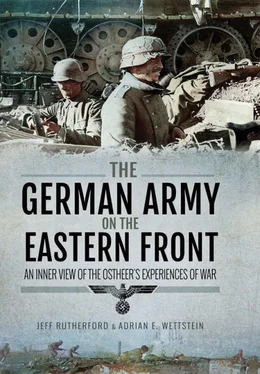2) Training subjects:
In the case of an overabundance of subjects, the emphasis should be placed on:
Reconnaissance patrols and assault group activity
Co-operation of all infantry weapons
Close-combat training,
Anti-tank close combat,
Sniper training,
Night fighting.
At the same time, the field replacement battalion is the winter combat school of the division.
3) Structure
The field replacement battalion is to consist of the battalion staff and 2 to 5 companies. Only the command, instruction and supply personnel are fixed in the unit, while the personnel to be trained are subject to considerable changes, depending on the deployment and situation of the division. Thus, for example, the following structure may be appropriate for a division to which a march battalion had been recently added:
Staff
2 training companies for infantry training,
1 training company for heavy infantry weapons training, 1 company [at the] disposal [of the commander] (engineer training, signal training, other specialists),
1 sub-leader company (divisional fighting school)
On the other hand, it is possible that in another division, to which no march battalion or replacements were added, the field replacement battalion consists only of
1 sub-leader company (divisional combat school), 1 company [at the] disposal [of the commander] (training of specialists of all kinds),
1 company for close combat and assault group training (men removed from the front for advanced training).
4) In particular, the following is pointed out:
The training of the sub-leaders must continue independently of all combat operations.
The most appropriate officers and NCOs are to be appointed as instructors, especially to set up and get used to each other in the first training period.
Anti-gas training belongs to the basic training of every soldier and is therefore also to be pursued in the field replacement battalion.
The field replacement battalion can only fully fulfill its task of being the field training battalion of the division when the leadership does not deploy the battalion prematurely in critical situations for combat, but pursues the training as planned independent of the situation.
In addition to further training for replacements and NCOs, the Field Replacement Battalion was also not only the unit where new weapons and tactics could be tested, but also a place for the further training of men whose long stretch in the trenches had decreased their effectiveness in offensive actions. The training for newly arrived replacements in the field replacement battalion allowed for their step by step integration into frontline units, as well as for the men to adapt to conditions in the Soviet Union. When the combat situation allowed for such a period, units that carried out these programmes clearly suffered fewer losses of new men when they were again engaged in combat. But even when armed with such knowledge, German units were often forced to deploy the field replacement battalion in crisis situations or to release the replacements prematurely to the front. The demand to train NCOs independently of combat action was often impossible due to the lack of men. Interestingly, the training issues stressed did not appreciably differ from the 1941 guidelines.
In addition to filling units with individual replacements, complete units were also sent to the east. Up to mid-1943, these were mostly full divisions. A first wave of divisions was sent to the Soviet Union in the 1941/42 winter crisis to fill gaps across the front. A second wave arrived in the east in spring and early summer 1942 for the German summer offensive. This wave included many allied units. A third and final wave was sent eastward from late November 1942 on to stem the Soviet offensive in the south. After these three waves, only a few new divisions were sent eastward, mostly rebuilt units such as numerous divisions destroyed in Stalingrad. Allied threats in the Mediterranean and on the Channel coast in 1943 drew most newly formed divisions to those regions. The introduction of new troops, however, caused many problems, in some cases due to the composition of the units, while others were due to the special conditions in the east, as the following autumn 1942 report by Sixth Army illustrates: [14]
1) The mistakes ascertained in the report of the Second Army about the formation of divisions with three hundred numbers also occurred in the divisions of the same type subordinated to the Sixth Army. In the case of future new formations, it is then necessary to avoid:
composition of almost only short-service, men classified as indispensable, numerous fathers with many children and last sons,
formation by cadre personnel mostly inexperienced in the East, including officers,
too brief and deficient infantry combat training.
It proved to be disadvantageous to order the few useful instructors to Döberitz and Jüterbog. Dispatching of a school’s instruction troop to the divisions would have been better.
Equipment with too little motorized transport capacity (only 1 small truck column), with horse-drawn bakery companies, with only one workshop platoon, with heavy military carriages instead of light commercial ones, with too many types (about 100) French motor vehicles and with horses that are too heavy, and thus unsuitable for the East;
Equipping [the unit] with horses and motor vehicles too late, so that it was no longer possible for the operating personnel to practice before employment.
2) In spite of these deficiencies, the 300-numbered divisions subordinated to the Sixth Army have proven themselves effective not only in attack, but also generally in defence.
3) In order to remedy the identified shortcomings during the winter:
A) Ruthless eradication of all unsuitable leaders and an increased replacement rate of men with Eastern experiences in contrast to other divisions,
B) Sustained further education during periods of relative quiet in individual and unit training up to the level of the reinforced battalion. For this, several weeks of relief for each unit. Use and training of individual battalions as instruction battalions at the company commander school of the army,
C) Remedy of the deficiencies found in the supply units by modifying the table of organization, the table of basic allowances and corresponding supply.
The divisions identified as numbering over three hundred, which primarily arrived in spring and summer 1942 to support the German summer offensive, suffered heavily from all kinds of shortages, be it men or material. While a lack of instructors with experience in the east only exacerbated the problem, the leadership of experienced divisional and, in some units, regimental commanders allowed these units to perform adequately after an initial learning curve. [15]They also profited from being transferred to the east prior to a German offensive, giving them time to settle and adapt to the conditions. Units sent eastward in the winter crisis were often hastily thrown piecemeal into battle and frequently suffered irreparable damage or were completely destroyed.
But even sending smaller units that should have been integrated into existing divisions proved very problematic, as the following report by the 5th Panzer Divisions indicates: [16]
The I./894 is subordinated to the Panzer Grenadier Regiment 13 since 22.11.1943. The experiences made with this unit appear so serious that it is considered appropriate to make higher levels aware of them.
Grenadier Regiment 894 was formed in June 1943 for security tasks on the Atlantic coast from soldiers non-suitable for the East, men who were previously rated as indispensable, in the mass soldiers classified as fit for reduced field service ( Garnisonsverwendungsfähig – Feld ), and deployed in the positions on the coast at the end of July 1943. On 20 October 1943, the 1st Battalion was removed from the regiment, and newly formed after the exchange of non-suitable soldiers. From the day of formation to the day of loading to the east, the battalion had 10 days available, which for the most part still had to be used for work for establishing [the unit].
Читать дальше






![John Stieber - Against the Odds - Survival on the Russian Front 1944-1945 [2nd Edition]](/books/405234/john-stieber-against-the-odds-survival-on-the-russian-front-1944-1945-2nd-edition-thumb.webp)





